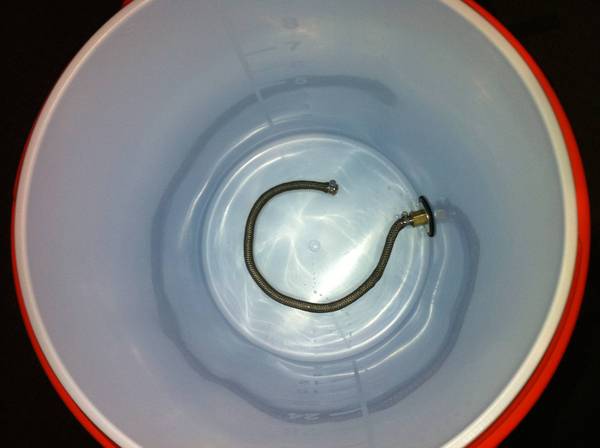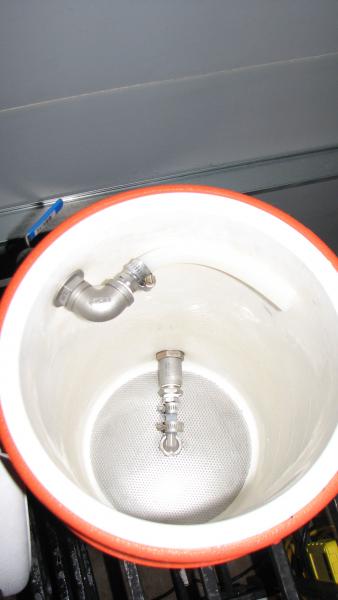I think you have more a math issue than a flaw in equipment or materials.
Personally, I think it is a combination of math and equipment.
On the math side, you can't really look at the gravity of your first runnings and determine that you are on track to hit your designed pre-boil gravity. The gravity of those first-runnings is going to be directly correlated to your liquor:grain ratio. If you mashed really thick, the initial gravity will be higher, but you will require more sparge water (which over time, will dilute you down to your target pre-boil gravity). If you mash thinner, the gravity of the first runnings will be lower, but you will require less sparging - so the diluting will be less drastic. In other words, the gravity reading of your first runnings was pretty much pointless. On the other hand, it is a nice practice to take a gravity reading of your
last runnings, because the literature says you really want to stop the sparge once you are collecting a wort between 1.008 and 1.014, for fear of the pH getting out of whack - which has been reported to lead to issues of astringency and tannin extraction.
If I had to advise a math strategy for your first several AG batches, I would say to build a recipe at 70% efficiency, conduct your mash and sparge as planned, collect your designed pre-boil volume, and then take an accurate gravity reading of the full wort volume. There is no way you can guess what kind of efficiency your system will output until you brew on it several times, but an estimate of 70% is a nice compromise. Odds are, you will be somewhere between 60-80%, so even if your gravity is off (and the only way it won't be "off" is pure luck), the batch will not be a bust. Once a trend forms, you can account for your efficiency on future grain bills, and really dial in your target gravity through recipe formation.
On the equipment side, the single braid is really not you best bet for a fly sparge. It will work, but it is not the best choice from a fluid dynamics stand point or in my experience, a durability stand point. There is a great section in the appendix of the on-line version of How to Brew about manifold designs and flow potential. Palmer explains better than I can, so here is the link.
http://howtobrew.com/appendices/appendixD-1.html
If you want to continue the fly sparge method, I really suggest maximizing the design of your lauter system. A slotted manifold is great, and in a round cooler, (IMO) a false bottom is even better. I know it is hard to pass up on the $1.50 braided toilet supply option, but in the long run, you will be happy you upgraded.
If interested, here is a false bottom for your 10G cooler.
http://www.brewmasterswarehouse.com/product/0102039/ss-false-bottom-12-in-diameter
I know $40 is a lot for such a specialty item, but I am so happy I switched to this product. As someone who has used a braid, a braided manifold, and now a false bottom, I can say from experience that the false bottom is head and shoulders above your current choice. It doesn't float, flop, twist, crimp, etc. It is simply the perfect design for seperating grain and wort during the lauter. Take a look below at the picture of my tun with the upgraded false bottom. What looks to you like a more capable medium of maximizing flow potential through the grain bed? What design looks more apt to fail - a ridgid stainless steel false bottom, or a floppy braid? I've seen the braid work fine for a batch sparge technique, but during a continuous sparge, you really expose its shortcomings.
In summary, I agree with the tone of your other thread as well - your crush is suspect. At the same time, it is only one of the many variables you need to consider in your process. You will have to combine an ideal crush (notice, I did not say an over-crush) with a well conducted lauter if you really want to obtain consistency from batch to batch.
Joe
 ). I followed the instructions from a popular thread here and did it pretty much as instructed. For separating the grains from the wort, I used the mesh tubing method which said to use 12" or more. I found a 20" tube and went with that. I made a nice curl with it since I figured I would get a better all around flow instead of just a straight line across the diameter of the tun. I couldn't figure out how to secure it to keep it from moving around but after I remove my grains, it didn't appear to have moved at all so I'm assuming that my lack of efficiency isn't from a path of least resistance issue with it being up against the wall.
). I followed the instructions from a popular thread here and did it pretty much as instructed. For separating the grains from the wort, I used the mesh tubing method which said to use 12" or more. I found a 20" tube and went with that. I made a nice curl with it since I figured I would get a better all around flow instead of just a straight line across the diameter of the tun. I couldn't figure out how to secure it to keep it from moving around but after I remove my grains, it didn't appear to have moved at all so I'm assuming that my lack of efficiency isn't from a path of least resistance issue with it being up against the wall. 


 ). I followed the instructions from a popular thread here and did it pretty much as instructed. For separating the grains from the wort, I used the mesh tubing method which said to use 12" or more. I found a 20" tube and went with that. I made a nice curl with it since I figured I would get a better all around flow instead of just a straight line across the diameter of the tun. I couldn't figure out how to secure it to keep it from moving around but after I remove my grains, it didn't appear to have moved at all so I'm assuming that my lack of efficiency isn't from a path of least resistance issue with it being up against the wall.
). I followed the instructions from a popular thread here and did it pretty much as instructed. For separating the grains from the wort, I used the mesh tubing method which said to use 12" or more. I found a 20" tube and went with that. I made a nice curl with it since I figured I would get a better all around flow instead of just a straight line across the diameter of the tun. I couldn't figure out how to secure it to keep it from moving around but after I remove my grains, it didn't appear to have moved at all so I'm assuming that my lack of efficiency isn't from a path of least resistance issue with it being up against the wall. 





